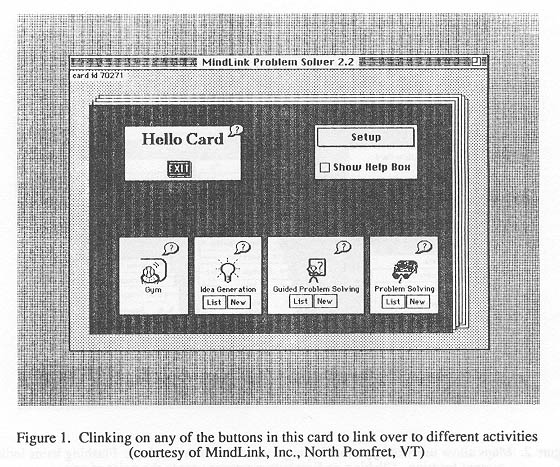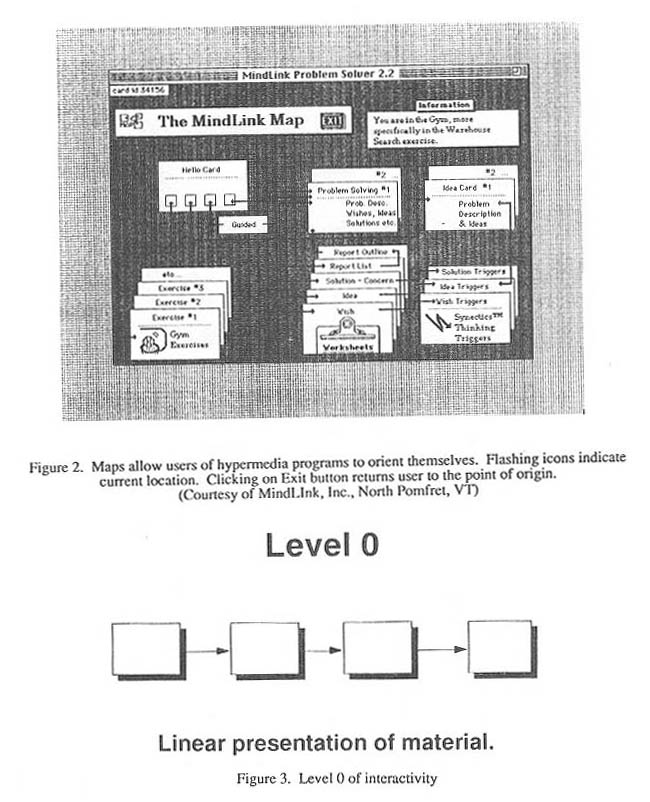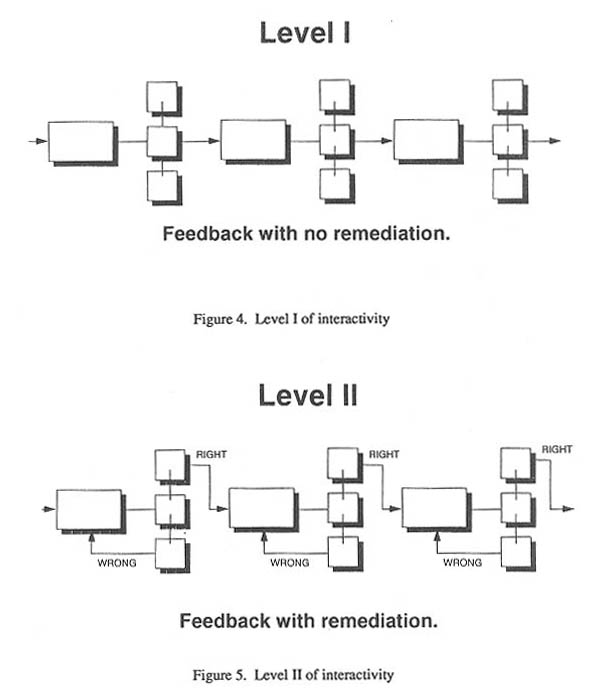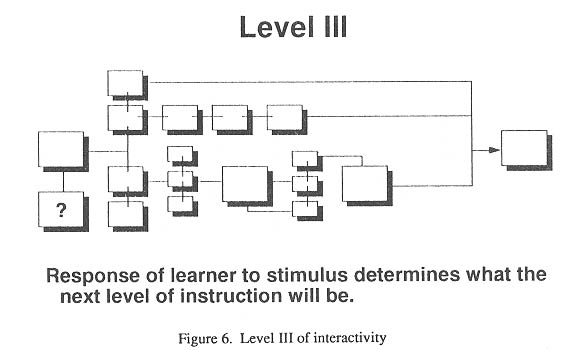
Thomas L. Vernon
Graduate School of Education
University of Pennsylvania
Philadelphia PA 19104-6216, USA
E-mail: tvernon@pobox.upenn.edu
Abstract: A brief overview of the elements of hypermedia, four levels of interactivity and how they can be best utilized to design interactive programs. Criteria for levels of user control vs machine control are discussed, as well as ideas for incorporating infor-mation on learning styles into interactive media design.
Although we think of active learning or student-directed learning as a new concept, its origins actually lie in classical Greece. There, the Delphic Oracle spoke to worshipers enigma-tically, and it was their own struggle to comprehend that led to a deeper understanding. (Goodrich, 1987) Today's multimedia programs allow learners to puzzle their way through games and simulations, and challenge users to think. Yet many programs are designed either with a very structured, linear approach, or include every feature available to the designer, with little thought to the instructional outcome. This paper discusses the important elements of hypermedia, the four levels of interactivity, describes some criteria for user control vs machine control, and discusses how an understanding of learning styles can assist in the design process.
2. HYPERMEDIA DEFINED
Hypermedia is an outgrowth of hypertext, which is a term coined by computer pioneer Ted Nelson in the 1960s. It referred to the non-linear, associative linking to text in a computer file. Its intent was to empower users by facilitating access in an associative fashion, the same way that the human brain functions. As technology advanced, the term hypermedia was used to describe a sys-tem where the user creates; interrelationships between text, ideas, images, and sounds.
Hypermedia's most advanced implementation to date is in a new form of electronic encyclo-pedia. With this new tool, users can follow their own associative links through material via videotapes, films, articles, bibliographies, and more. Included in the system is the capability for automatic language translation, continuous updating, and unlimited expansion of the encyclopedia. (Glushko, 1990)
3. HYPERMEDIA FUNDAMENTALS
There are several structural elements common to all hypermedia programs: nodes, links, and buttons. Nodes are the basic unit of information in hypermedia. These may take the form of text fields, digitized sound bites, visual images, or QuickTime movies.
Students working on research projects soon discover that no single fact exists in a vacuum. It depends on links to other chunks of information to give it meaning. A researcher may record facts on 5 X 7 cards, and quickly become frustrated when he tries to file them in a logical or alpha-numeric system. Many cards could easily fit in several locations. Add to this the difficulty of finding references that may be in any of several locations, and the problem grows more complex.
This is the dilemma that is addressed by the links within hypermedia. These links connect nodes of information, and may be structured by the designer in any way from linear to open-ended. Two users of the same hypermedia program may well link their way through the know-ledge base in completely different ways, to arrive at the same end point.
Links may also be established to information external to the hypermedia program. For example, architecture students may access a project management software program running on a mainframe to learn about the complexities of scheduling large construction projects. These links insure that the content is current, without having to periodically revise the program.
Buttons are the vehicles which activate links. As their name implies, they often appear gra-phically as buttons, knobs, or icons which are activated by clicking a mouse on them. However virtually anything on the screen may be used as a button. Words within a text field may be out-lined, and serve as buttons. These may then link to a glossary with a definition of the word selected. A HyperCard program with icons linking to different stacks is shown in Figure 1.
One of the major problems with hypermedia programs is disorientation. It may become dif-ficult for the user to visualize how the information is linked together, and to keep track of where they are. Maps are the best solution to this problem. They typically take the form of graphical representations of how the material is organized. Often a flashing icon or maker on the map shows the user where he or she is. Large programs may have parent maps and child maps, and include a visual representation of the links the user has taken to get where they are. Figure 2 shows a map from a typical HyperCard program.
A useful tool for more structured programs is a table of contents where the user can return to start a new unit of instruction. As each unit is completed, it is automatically checked off on the table of contents. This permits the user to check his progress at a glance.
4. INTERACTIVITY DEFINED
Four levels of interactivity are generally recognized in the development of interactive ma-terials. Level 0 is simply a linear presentation of information, as shown in Figure 3. No interac-tivity takes place. Also known as 'electronic page turning', it has very limited application in interactive media. Generally its use is restricted to brief introductions or instructions. If course-

ware has a significant amount of text, either as explanations or exercises, it is better to have a workbook to accompany the course. For portability, this material may be included on the program disk as a text file which is printed out by the user.
At level I, shown in Figure 4, the first level of interactivity, information is presented and the learner is asked to respond to a question about the material. Feedback is limited to revealing the correct answer to the learner. No remediation is supplied. This format is useful for drill and practice exercises, or electronic flash-cards.
Level II has two subcategories: review of old instruction, and branching to new instruction. In the review of old instruction, when the learner makes an incorrect response he or she is bran-ched back to the original material. This approach has the limitation of not providing the learner with any insight as to why he made the wrong response. The alternative, branching to new ma-terial, allows the developer to custom-design responses to the type of mistake that the learner made. Motivation, instruction, practice-feedback, and evaluation may all be present. This is illustrated in Figure 5. This type of interactivity may be useful for frame-based mastery instruc-tion. Some hypermedia courses, and most CBT programs fall into this category, either as a function of limited funds, or vision restricted to linear or hierarchical presentation of earning materials.


In the final level of interactivity, Level III, the response of the learner to a stimulus determines what the next level of instruction will be. For example, incorrect responses may each link to different remediation frame, based on the nature of the learner's mistake. This may be a video segment, text, or sound narration. A series of correct responses may permit the user to skip ahead more quickly. Level III interactivity allows for many types of simulation and gaming exercises, as illustrated in Figure 6. It is today's hypermedia programs that support this most advanced level of interactivity.

5. USER CONTROL VS. MACHINE CONTROL
Although utilizing hypermedia to its fullest potential entails design with associative links, some basic needs can be met by developing a more structured environment for students to work in. Some examples include: vocabulary drills, electronic flash-cards, and drill and practice materials. An emphasis on machine control should also be maintained with younger learners or learners who have little familiarity with the subject material. Among college-age and adult learners, several criteria for level of control have been identified: (Gery, 1987). Use a high level of machine con-trol when:
• Learners are used to highly structured learning experiences.
• Learners are used to being told what to do.
• There are requirements that students have experienced specific
material (certification).
• The subject matter requires cumulative knowledge for
competency.
• Learners don't know what they need or want to know about this
content.
• Learners have little experience with independent learning.
Use a high level of learner control when:
• Learners know what they want or need to learn
• Learners are motivated to learn and see personal relevance to
learning the material or acquiring the skill.
• Learners have experience and comfort with self-directed learning.
• The program content is not necessarily linear and the learning
sequence is not critical.
• Learning the content is largely discretionary rather than required.
6. ADAPTING HYPERMEDIA TO LEARNING STYLES
Hypermedia programs may be custom-tailored to address different student learning styles. One example would be left/right brain learning. Researchers have determined that the left and right hemispheres of our brain process information differently. The left brain is logical, linear and analytic. The right brain is visual and creative. (Springer and Deutsch, 1985) Further, we know that almost everyone has one cognitive orientation, or mode of learning, that is either visual or analytic. Only 7% of the population is whole brained, or able to function effectively in both hemispheres. In Western culture, the left brain is usually dominant. Students who favor a visual mode typically have a great deal of trouble with abstractions. Seeing something usually means understanding it all at once, while abstractions involve linear thinking. In subjects that require mastery of material that involves both components, virtually all students will experience difficulty. Examples of these disciplines include neuroanatomy, mineralogy, architecture, and physiology.
It is important to understand some of the difficulties that may arise when teachers teach and learners learn in their preferred styles, without an understanding of their differences. Teachers often perceive students who learn in a manner that does not match their teaching style as less intelligent or poorly motivated. Students perceive teachers with a style different that their own as poorly organized or ineffective.
An instructor may design a hypermedia program that addresses the needs of both types of learners, and allows each to approach the material in the way that feels most comfortable. Through the skillful weaving of text fields, buttons and links, a program may be created where students can begin the exploration in their preferred style. As comprehension begins to take place, students may use the program's links to explore the same body of knowledge from a different perspective.
Another adaptation of hypermedia to learning styles could involve structuring groups of exam questions. In Sternberg's model of mental self-government, three types of learners are identified: executive, judicial, and legislative. (Sternberg 1990) Learners who favor an executive style prefer structured problems, and implementing and doing tasks using familiar approaches. Students with a judicial style prefer to compare and contrast materials created by others. Those favoring a legislative style prefer open-ended, unstructured problems, where they can use their imagination to create innovative solutions.
These three groups of students would approach a new body of knowledge in completely different ways, and would demonstrate their competency differently. This in mind, an instructor could design course materials that permit students to demonstrate mastery of subject material in the way they are most comfortable, but also stretch and understand the other styles as well. For example, a course on the history of World War II might include a computer-based test bank with three types of questions corresponding to Sternberg's learning styles. Students whose preferred style is executive might receive an exam where most of the material is in the form of objective questions - true/false or multiple choice. Learners who favor a judicial approach may receive a majority of their questions in the form of 'compare and contrast' essays, where different historian's interpretations of events may be evaluated. Finally, students who work best in the legislative style might receive a series of essay questions on the history of World War II that are more open-ended and call for a great deal of creativity. An example may be to play the part of Harry Truman and create a completely different scenario for the end of the war...without the use of nuclear weapons.
There are many other ways of developing instructional materials in terms of learning styles. There are several models, and the developer must understand which one best serves his or her needs. Material may also be developed with respect to gender, (Belenky, 1983) multiple intelligence theory (Gardner, 1986) or student developmental stages (Perry, 1970).
7. SUGGESTIONS FOR DEVELOPERS
The most important point for new developers of hypermedia materials to remember is that it is not the same as creating classroom materials. The dynamic nature of the classroom allows both teachers and students to compensate for inadequately developed materials. Instructors can offer alternate explanations or put additional diagrams on the board, and students can ask more questions until the information makes sense.
Hypermedia has none of this slack. It is a precise and unforgiving medium in terms of inadequate organization. New developers would be well advised to start with a small project, develop it fully in terms of flowcharts and story-boards, and test it thoroughly before releasing it. Often it is useful to observe beta testers to see how easily they move through the information and if there are points of confusion. The feedback that you receive from these people will be invaluable in fine-tuning the program. The new developer should start projects long before they will be needed, as the process just described always takes much longer than expected!
Other important criteria are the amount of user control and simplicity of design. As the development process begins, the structure must be designed with the right amount of user control. Too much freedom or too much structure can alienate your audience. A recommended path through the material should be suggested, but the user should be allowed to wander as his unique interests and mental associations dictate. Many new developers are dazzled with all of the special effects that are easy to incorporate within this environment, and feel that their students must be dazzled as well. Simplicity is the cornerstone of effective instructional materials. Learners should walk away from a program remembering its content, not the transition effects between frames.
The good news is that you don't have to be a computer programmer to develop good instruc-tional materials. Most hypermedia programs allow you to do design work by dragging buttons and fields into place and sizing them. A minimal amount of scripting is necessary, and this is usually done in an English-language based environment. About all you need to get started is the hypermedia software, time and patience
8. CONCLUSIONS
We are now at a point in our evolution where culture
is no longer driving the technology, rather the technology is driving our
culture. Newer development platforms will soon replace today's multimedia
equipment, and it will become increasingly difficult for the educator to
stay abreast of the latest developments in hardware and software. Yet with
a knowledge of good hypermedia design - allowing the student to link new
material with what he or she already knows, the instructor will be able
to develop effective teaching tools that can be readily transported to
new platforms as the technology evolves.
REFERENCES
Bolter, Jay. Writing Space. Hillsdale NJ: Erlbaum, 1991.
Gardner, Howard. Frames of Mind: The Theory of Multiple Intelligences. New York: Basic Books, 1986.
Gery, Gloria. Making CBT Happen. Boston MA: Weingarten Publications, 1987. An excellent description of the technical, political, and logistical aspects of creating CBT programs in a corporate environment.
Glushko, Robert J. "Designing a Hypertext Electronic Encyclopedia." ASIS Bulletin 16 (3): : 14-16, 21, 22 (February-March 1990).
Goodman, Danny. The Complete HyperCard Handbook. New York: Bantam Books, 1988
________________. Danny Goodman's HyperCard Developer's Guide. New York: Bantam Books, 1988.
This, along with Danny Goodman's other book, are essential references for anyone wishing to develop an effective HyperCard program.
Goodrich, Norma L. Priestesses. New York: Franklin Watts, 1989.
Heinich, Robert, Molenda and Russel. Instructional Media and the New Technologies of Instruct-ion. New York: Macmillan Publishing Company, 1989.
Kemp, Jerrold E. Planning and Producing Audiovisual Materials. New York: Thomas Y. Crowell Company, 1975.
Long a classic, Kemp's book is one of the best "hands on" texts for producing instructional materialS. Essential reading for anyone who likes to get their hands dirty. The chapters on planning provide useful background reading for those interested in developing media materials.
Ornstein, Robert E. The Psychology of Consciousness. San Francisco: W.H. Freeman and Co., 1972.
Perry, William G. Forms of Intellectual and Ethical Development in the College Years: A Scheme. New York: Holt Rinehard, 1970.
Springer, Sally, and George Deutsch. Left Brain, Right Brain. New York: W. H. Freeman and Co., 1985.
Sternberg, Robert J., "Thinking Styles: Keys to Understanding
Human Performance," Phi Delta Kappan (January 1990): p. 366-371.
Good summary of Sternberg's theory of mental self-government.